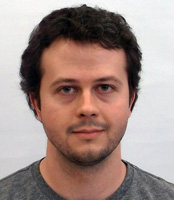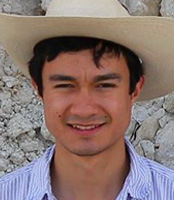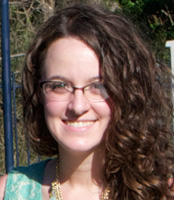New Frontiers Initiative (NFI) and Blue Waters (BW) Graduate Fellowship Programs
| 2015-2016 Blue Waters Graduate FellowsSix outstanding computational science PhD students from across the country have been selected to receive Blue Waters Graduate Fellowships for 2015-2016. These fellowships provide graduate students in diverse fields with substantial support and the opportunity to leverage the petascale power of NCSA’s Blue Waters supercomputer to advance their research.
|
Skip to Content


 Thomas Allen, University of Illinois at Urbana-Champaign. Understanding biological charge transfer reactions is of critical importance, both as a window into fundamental metabolic processes and also as a fertile source of ideas for cutting-edge technological challenges, including energy storage and the development of novel catalytic materials. A major challenge in simulating these processes is the inherently quantum nature of the electrons and protons involved, demanding significant computational effort to study realistic systems. During his fellowship, Allen will use a new quantum-classical method recently developed by the research team of his advisor to perform unprecedentedly rigorous calculations on the proton transfer reaction occurring in triosephosphate isomerase, a major contributor to the glycolytic pathway.
Thomas Allen, University of Illinois at Urbana-Champaign. Understanding biological charge transfer reactions is of critical importance, both as a window into fundamental metabolic processes and also as a fertile source of ideas for cutting-edge technological challenges, including energy storage and the development of novel catalytic materials. A major challenge in simulating these processes is the inherently quantum nature of the electrons and protons involved, demanding significant computational effort to study realistic systems. During his fellowship, Allen will use a new quantum-classical method recently developed by the research team of his advisor to perform unprecedentedly rigorous calculations on the proton transfer reaction occurring in triosephosphate isomerase, a major contributor to the glycolytic pathway. Maureen Brooks, University of Maryland College Park. Sargassum is iconic in the North Atlantic, but the mechanisms enabling this seaweed to provide habitat for fishes, turtles and microorganisms in one of the most nutrient poor gyres of the globe are unknown. Features such as eddies can both disperse Sargassum and alter local nutrients through upwelling. Brooks will conduct a modeling study to link Sargassum distribution mechanistically to physical, biogeochemical, and organismal processes. The computing power of Blue Waters will enable the coupling of eddy resolving ocean circulation, biogeochemical, and Lagrangian particle Sargassum community models. Lagrangian coherent structure analysis will be used to determine the role of eddies in dispersal and growth of Sargassum.
Maureen Brooks, University of Maryland College Park. Sargassum is iconic in the North Atlantic, but the mechanisms enabling this seaweed to provide habitat for fishes, turtles and microorganisms in one of the most nutrient poor gyres of the globe are unknown. Features such as eddies can both disperse Sargassum and alter local nutrients through upwelling. Brooks will conduct a modeling study to link Sargassum distribution mechanistically to physical, biogeochemical, and organismal processes. The computing power of Blue Waters will enable the coupling of eddy resolving ocean circulation, biogeochemical, and Lagrangian particle Sargassum community models. Lagrangian coherent structure analysis will be used to determine the role of eddies in dispersal and growth of Sargassum. Justin Drake, The University of Texas Medical Branch. For most of the 20th century it was widely believed that the relatively well-defined structure of a protein dictated its function. However, over the past decade it has become clear that many proteins rely on intrinsically disordered regions (IDRs) to bind other proteins and carry out their function. IDRs may fold, unfold, or redistribute their conformational ensemble upon binding to their targets. The thermodynamic coupling of these events with the free energy of protein binding remains obscure. In this project, Drake will use molecular simulations and computational biophysics to examine the extent of which conformational entropy of IDRs contributes, or even dominates, the free energy of protein binding.
Justin Drake, The University of Texas Medical Branch. For most of the 20th century it was widely believed that the relatively well-defined structure of a protein dictated its function. However, over the past decade it has become clear that many proteins rely on intrinsically disordered regions (IDRs) to bind other proteins and carry out their function. IDRs may fold, unfold, or redistribute their conformational ensemble upon binding to their targets. The thermodynamic coupling of these events with the free energy of protein binding remains obscure. In this project, Drake will use molecular simulations and computational biophysics to examine the extent of which conformational entropy of IDRs contributes, or even dominates, the free energy of protein binding. Joshua Méndez, Georgia Institute of Technology. In volcanic plumes, ash particles readily charge via triboelectric processes. Perhaps the most dramatic consequence of ash electrification are the brilliant displays of lighting that often accompany volcanic eruptions. The charging behavior of a plume is related to the physical, chemical, and dynamic properties of the granular material, implying that electromagnetic signals generated by plumes likely retain information about the opaque interior dynamics of the volcanic clouds themselves. In other words, the electrostatic nature of plumes can be used to remotely monitor eruptions. To interpret sensed field data, the research team has developed a high-resolution volcanic plume model that links the microphysical charging processes of ash to the evolution of electric fields and lightning generation.
Joshua Méndez, Georgia Institute of Technology. In volcanic plumes, ash particles readily charge via triboelectric processes. Perhaps the most dramatic consequence of ash electrification are the brilliant displays of lighting that often accompany volcanic eruptions. The charging behavior of a plume is related to the physical, chemical, and dynamic properties of the granular material, implying that electromagnetic signals generated by plumes likely retain information about the opaque interior dynamics of the volcanic clouds themselves. In other words, the electrostatic nature of plumes can be used to remotely monitor eruptions. To interpret sensed field data, the research team has developed a high-resolution volcanic plume model that links the microphysical charging processes of ash to the evolution of electric fields and lightning generation. Larissa Reames, the University of Oklahoma. The goal of this study is to quantify the relative importance of environmental changes due to alterations in surface roughness, thermal characteristics and their interaction within urbanized areas on thunderstorm dynamics. For this study, the Advanced Research Weather Research and Forecasting model will be used with urban areas inserted or removed from the simulations as needed. The effects of different city sizes and shapes on boundary layer and supercell storm characteristics will be explored first. This will be followed by sensitivity tests and factor separation to determine whether the dynamic or thermodynamic effects associated with the urban area yield larger changes in the simulated supercell storms.
Larissa Reames, the University of Oklahoma. The goal of this study is to quantify the relative importance of environmental changes due to alterations in surface roughness, thermal characteristics and their interaction within urbanized areas on thunderstorm dynamics. For this study, the Advanced Research Weather Research and Forecasting model will be used with urban areas inserted or removed from the simulations as needed. The effects of different city sizes and shapes on boundary layer and supercell storm characteristics will be explored first. This will be followed by sensitivity tests and factor separation to determine whether the dynamic or thermodynamic effects associated with the urban area yield larger changes in the simulated supercell storms. Sam Totorica, Stanford. Using the state-of-the-art, massively parallel particle-in-cell code OSIRIS, Totorica will perform ab initio simulations of magnetic reconnection in laboratory laser-driven plasmas. Employing heterogeneous programming, he will implement a novel force calculation algorithm in OSIRIS through a multidisciplinary approach involving aspects of dark matter simulations, applied math, and computational geometry. The new algorithm will allow him to model realistic experimental systems while still resolving microscale physics, enabling an unprecedented investigation of the interplay between the different scales and physics regimes. These simulations will be used to guide laboratory astrophysics experimental programs, and shed light on cosmic ray acceleration.
Sam Totorica, Stanford. Using the state-of-the-art, massively parallel particle-in-cell code OSIRIS, Totorica will perform ab initio simulations of magnetic reconnection in laboratory laser-driven plasmas. Employing heterogeneous programming, he will implement a novel force calculation algorithm in OSIRIS through a multidisciplinary approach involving aspects of dark matter simulations, applied math, and computational geometry. The new algorithm will allow him to model realistic experimental systems while still resolving microscale physics, enabling an unprecedented investigation of the interplay between the different scales and physics regimes. These simulations will be used to guide laboratory astrophysics experimental programs, and shed light on cosmic ray acceleration.